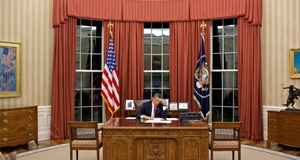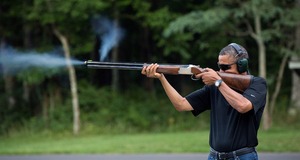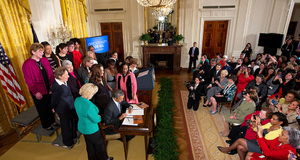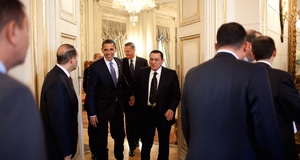The Obama PresidencyThe Urban President: Assessing Obama's Community Redevelopment Policies
By
2015, Vol. 7 No. 02 | pg. 1/3 | »
IN THIS ARTICLE
KEYWORDS
On February 27, 2014, while surrounded by nearly two dozen African-American young men in the East Room of the White House, President Barack Obama passionately introducing his My Brother’s Keeper initiative. After briefly joking with the young students about taking the day off from school to join him, President Obama shifted to a much more serious tone to address the press and televised audience. He delved into his own troubled youth and his shared experiences with the young men behind him. However, the President began to make an important distinction between his past and the struggles of the young men behind him, reminiscing on how he was lucky enough that the environment in which he grew up stifled many of the severe repercussions of his missteps. More than just his parents and grandparents, he noted the important roles of his teachers and members of the community, how they would, “…push me to work hard and study hard and make the most of myself. And if I didn’t listen they said it again. And if I didn’t listen they said it a third time. And they would give me second chances, and third chances. They never gave up on me, and so I didn’t give up on myself.1” For President Obama, policy agenda points addressing the systemic issues facing urban minority youth and communities have not moved quickly enough. His impressive electoral victory over Senator John McCain in 2008 represented a seminal point in American politics and a shattering of widely held norms. The first non-Southern Democrat was elected to the office of the Presidency since John F. Kennedy.2 A young black family now resides in the White House. Incredibly high youth and minority voter turnout and changing demographic and vote distributions were significant developments in both the 2008 and 2012 elections. I argue that these altering dynamics, in conjunction with President Obama’s personal background and experiences as well as a heightened sense of political efficacy, point toward a clear mandate for executive action in addressing urban community development issues.
Joking with Chris Paul, who introduced the President for a town hall to promote "My Brother's Keeper, "July 21, 2014. Photos: Pete Souza/White House In the context of a hyper-polarization of both political parties and a degraded economy, the first term of the Obama Presidency was largely marked by the response to the 2007-2009 financial crisis and the national economy’s recovery. Over the course of the past few years, many of the economic mitigation measures taken by the administration have proven to be successful, though certainly caveated. Despite his mandate for urban focused policy, economic and demographic data reveal that concentrations of poverty have re-emerged in American metropolitan areas. A November 2011 report by the Brookings Institution noted a rise in concentrations of poverty by 3.5% in 2010 alone.3 Concentrations of poverty are defined as neighborhoods where at least 40% of the population lives below the poverty line, producing disastrous socio-political and economic effects across generations.4 Solutions to concentrated poverty and the resulting intergenerational transmission of disadvantage have eluded policymakers for decades. Though the dynamics of this phenomenon have shifted slightly in the 2000’s,5 it largely remains an urban community development issue. President Obama’s background and apparent urban mandate would suggest greater attention to remediating this issue. This chapter will discuss the existence of President Obama’s urban mandate, and the growth of concentrated poverty in the 2000’s. In addition to this discussion, policy analysis of three key Obama Administration urban community development initiatives will be offered, culminating in an assessment of the President’s performance in this area of his agenda. A Mandate for Change in America’s MetrosIn discussing President Obama’s mandate for addressing metropolitan community development and poverty issues, it is important to first note the transformation of the American electorate over the course of his Presidency, and the implications this has on constituency services. The 2008 Presidential election between Senators Barack Obama and John McCain saw an increase in over 5 million votes from the 2004 election cycle. According to US Census data, black and Hispanic voter demographics increased by 2 million voters each,6 while overall voter turnout reached its highest level since the 1968 election at 63.6%.7 For the first time in history, black voter turnout was on par with white voter turnout rates, constituting 33% of the vote margin of victory over Senator McCain.8 Within these increased overall turnout and minority turnout figures are significant waypoints for the traditionally under-represented demographic cohorts. Though still the lowest voting rate, 18 to 24 year olds showed the only statistically significant increase in voting rates, up to 49% of eligible voters in that range.9 In analyzing a case study of the electorate in Virginia during the 2008 election, urban scholars Bernadette Hanlon, John Rennie Short, and Thomas Vicino draw two important conclusions in regards to Barack Obama’s victory and shifting dynamics in American metros.10 As the authors note, Virginia has voted Republican consistently since 1968, going against national electoral trends by electing Gerald Ford and Bob Dole.11 Despite its historically red roots, Barack Obama took the state and its thirteen Electoral College votes with 52.6% of the vote.12 This shift in the electorate shows a convergence of economic assets and the voice of political and policy discourse to metropolitan regions,13 and a growing complexity in the city-suburb divide not found in the traditional analysis of metropolitan areas.14 The resurgence of Washington, DC as not simply a center of government but as a global economic hub; the centrifugal growth of important business centers like Arlington, VA due to increased land-rent in the center city; accrued and increasing density expanding outward from the center with increasing regional population and gentrification of the urban core; and the declining homogeneity of the North Virginia new-town developments were all important factors in Barack Obama’s victory. Continued demographic analysis shows that suburbs are no longer the heterogeneous homes to white, middle class, nuclear families, conflicting with Robert Wood’s theories on party affiliation changes due to residential movement.15 Wood offers two key theories that once helped to explain the Republican control of the suburban electorate: conversion and transplantation.16 This conversion refers to the leaving behind of the multi-cultural and cosmopolitan characteristics of urban neighborhoods in exchange for the more homogenous, family-oriented and wealth accumulation values of the suburbs. The theory of transplantation is based on the tenant that wealth and status are reflected in home ownership. When renters move to homes in the suburbs, they have attained a certain degree of wealth and become more risk-averse and economically conservative after the commodification of their wealth and assets in the form of a home.17 The growth of diversity, both in background and income, of suburban residents over the past decade has proven to break down these theories of affiliation in favor of models that best galvanize political bases in now contentious suburban spaces. Similar to the developments in 2008, the 2012 Presidential election cycle saw an increase in roughly 1.8 million votes compared to the 2008 estimates. This increase is paired with key voter demographic changes, as white, non-Hispanic voters decreased by nearly 2 million while black and Hispanic voters increased by nearly 1.6 and 1.4 million respectively from 2008.18 Though both elections of Barack Obama displayed dramatic increases in minority voter registration and participation, the motives of these voters must be called into question to fully assess and validate President Obama’s mandate for change in America’s metros. The record-high 15.9 million ballots cast by African-American voters for the first African-American candidate for President inherently raises questions as to how large of a role racial identity plays in voter behavior. Most studies performed on black political participation have focused primarily on the psychological concepts of shared racial identity, linked fate, and empowerment.19 Though the presence of these concepts and the consequential drive for greater participation in the 2008 and 2012 election cycles likely played a role for many black voters, scholars Tasha Philpot, Daron Shaw, and Ernest McGowen argue that they are neither suitable to explain why nor assume that black voters will turnout more for the election of a black politician. Important emphasis must be given to the reinvigoration of grass roots and community organizing campaign tactics promoted by Obama For America (OFA). Formerly, scholarly models of participation in black communities followed the typified progression of, “Black candidates increase political interest among black voters, which increases a sense of shared racial identity and the desire to support someone from one’s own group, which increases voting.20” However, in the case of increasing black voter participation, breaking down the history and, if not in law, perceived barriers of centuries of racism, inequality, and segregation are more important than simply the ability to connect to a candidate because of shared racial identity. Legacies of voter repression and a lack of civic engagement continue to plague many of these communities to this day. Democratic Party and OFA officials attempted to break down these norms through aggressive voter contact to make sure voters in previous elections remained engaged in the political process by co-opting their experience and transforming it into grassroots advocacy; by developing partnerships with inner-city minority church groups, neighborhood associations, ongoing community campaigns, labor unions, as well as local and district level Democratic campaigns in order pool resources, volunteers, community leadership, and precinct-level awareness of needs and concerns; and through an emphasis on developing and directing campaign operations within these communities instead of from towering central business district consulting offices. These tactics, certainly honed during Barack Obama’s time as a community organizer in the South Side of Chicago, were certainly effective, both in terms of quantitative analysis and on-the-ground reporting. While directing a satellite field office in the Dudley Square neighborhood of Boston’s Roxbury section, I saw these tactics and results unfold first hand during the 2012 election. A retired, unionized bus driver had offered up the office space I operated out of on a month-to-month lease basis after losing his tenant after years of economic stagnation in the predominantly black and Puerto Rican neighborhood. A series of local campaigns and then OFA revitalized the once vacant storefront and brought advocacy and resurgent pedestrian life to the neighborhood’s busiest street. In my efforts, I engaged dozens of members of the community, from retired church-going women to interested sixteen-year-olds from the local O’Bryant School of Math and Science. My team and I facilitated phone banks and canvasses, giving volunteers the expressed directions to connect with potential voters on a personal level by telling them their own story and why this election mattered to them. A heightened sense of racial identity and the grass roots and community organizing campaign tactics inherent in Barack Obama’s background and personal experiences were without doubt important factors in the increased turnout rates of African-American voters. Though these factors, along with changing demographics, were pivotal in his election and his subsequent re-election, I argue that the most important factor in constructing his mandate for change in the country’s metropolitan areas has come out of a heightened sense of political efficacy. The political efficacy model of voter turnout behavior is rooted in rational choice theory. Though economic, social, and psychological factors are apparent, voters are more inclined to participate not because of who is running, but because of the incentives and choices the candidate makes.21 OFA and Barack Obama himself, by employing grass roots campaign efforts in disadvantaged communities and in rhetoric that empowered youth and minority voters in the political process, promoted a sense of inclusive governance and a stake in policymaking. The campaign and early promises by Barack Obama acted in a way to make a clear distinction between his Presidency and his predecessors. The political time of the 1990’s and 2000’s, with the rise of a Republican Congress and Presidencies out of touch with urban community issues, marked a significant decrease in African-Americans’ confidence in governance and belief that their issues mattered to the decision makers.22 Though much attention is given to the mobilization of black voters, it is important to recognize the divergence of Barack Obama from prior African-American candidates, as the scope of his mandate is not limited to minority communities. President Obama has been described as a member of the new generation of black leaders that are removed from the Civil Rights Movement, deemphasize race in campaign rhetoric to appeal to a broader base, and are highly educated.23 With 83% of residents living in metropolitan areas that support 85% of US jobs, the balancing act of touting shared racial identity while connecting with a wide array of voters on the overall benefits of economic, social, and community revitalization was equally important to Obama’s electoral success.24 I argue that the combination of Barack Obama’s racial identity, background in community organizing, ability to adjust to the changing dynamics in America’s metropolitan areas, and involvement of urban voters in the campaign and political processes both heightened these communities’ sense of political efficacy and constructed his mandate to bring change and redevelopment to the underserved communities of the country’s cities.Continued on Next Page » Suggested Reading from Inquiries Journal
Inquiries Journal provides undergraduate and graduate students around the world a platform for the wide dissemination of academic work over a range of core disciplines. Representing the work of students from hundreds of institutions around the globe, Inquiries Journal's large database of academic articles is completely free. Learn more | Blog | Submit Latest in Political Science |




















